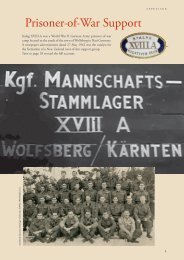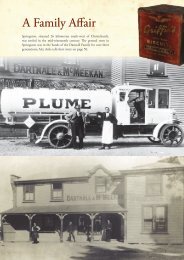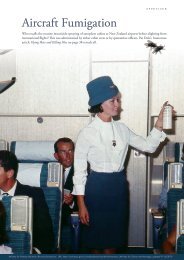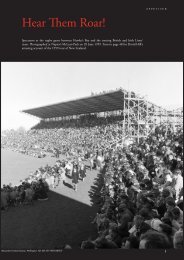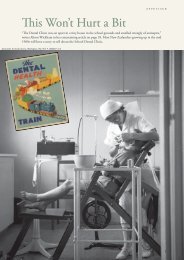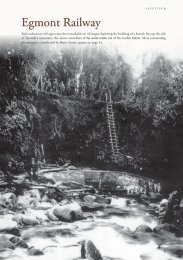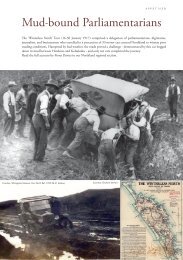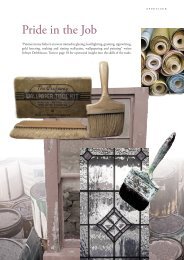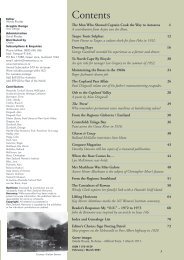Create successful ePaper yourself
Turn your PDF publications into a flip-book with our unique Google optimized e-Paper software.
APPETISER
A Family Affair
Springston, situated 26 kilometres south-west of Christchurch,
was settled in the mid-nineteenth century. The general store in
Springston was in the hands of the Dartnall Family for over three
generations; Alec Astle tells their story on page 50.
1
EDITORIAL
Dear Readers,
In our striking cover photograph, the Auckland Tramping Club pause at the
Commercial Hotel in Dargaville before continuing onto the Waipoua Forest for
a tramping expedition. It’s interesting to note the outfits in 1928; suit and ties
for men and dresses, coats and hats for the women… and on the back of a truck.
Fashion trends have certainly become more casual over the years. Even moving
forward to 1964, Ralph Levinson writes in his account of Joining the Workforce,
“I owned two white shirts and one pair of shoes – each evening I washed a shirt,
pressed the other and polished my shoes”. Of course it seems contradictory (and
laughable) nowadays that these same men’s formal shirts, ties and black shoes were
combined with ‘dress’ shorts and long socks as summer workplace attire for the office.
And moving on to uniforms of an entirely different variety; who amongst our readers belonged to the Scouting
Movement? Perhaps you attended the same 1959 Jubilee described in David Hill’s article and prepared to ‘Be
Prepared’ no matter what. Man-powered employee Joan Leonard sewed Relax brand raincoats for servicemen
during the war years - not that much relaxing would have been on the cards for World War II soldiers!
Onto other topics, Alec Astle profiles the remarkable Dartnall Family who operated a Canterbury general store
for three generations, Mick Hodder’s remarkable leading story relates to his upbringing in a railway house
during the 1930s and Wendy Clark remembers the ‘night soil man’ on Auckland’s North Shore.
John Stackhouse, an author with a taste for the unusual, is welcomed back with a ‘Whodunnit’ for readers to
puzzle. The intriguing collection of illustrative cartoons gives readers a glimpse of the First World War through
the eyes of a New Zealand soldier.
Nothing beats enjoying a good read on a cold wintry afternoon and our authors have contributed an assortment
of worthy stories in this 157th edition.
Keep warm and stay well,
Wendy Rhodes,
Editor
For just $57 you receive four superb
issues of New Zealand Memories
direct to your letterbox.
A G i f t o f D i s t i n c t i o n
Surprise a friend or relative with a gift. We will gift
wrap the first issue, include a gift card with your
personal message and post it direct.
Freephone: 0800 696 366 or
Freepost: 91641
PO Box 17288
Green Lane, Auckland 1546
Email: admin@memories.co.nz
Visit our website w w w.memories.co.nz for back issues and gift ideas.
Order online securely today and pay via internet banking or credit card.
2
Editor
Wendy Rhodes
Graphic Design
Icon Design
Administration
David Rhodes
Distributed by
Are Direct
Subscriptions & Enquiries
Phone tollfree: 0800 696 366
Mail: Freepost 91641,
PO Box 17288, Greenlane, Auckland 1546
email: admin@memories.co.nz
www.memories.co.nz
$57 for four issues
(Price includes postage within NZ)
Contributors
Alexander Turnbull Library, Wellington,NZ
Astle, Alec
Auckland Libraries Heritage Collection
Clark, Wendy
Clover, Ken
Dove, Rodney
Hill, David
Hirst, Helen
Hodder Alan
Janes,Terry
Leonard, Joan
Levinson, Ralph
Nelson Provincial Museum
Paeroa and Districts Historical Society
Pickmere, Alan
Rhodes, Donald
Smith Judith
Smith, Malcolm
Stackhouse, John
Stewart, Graham
Subritzky, Mike
Tairawhiti Museum
Ujdur, S
Veronese-Cowell, Tania
Veronese, Zeff
Waipu Museum
Whakatane District Museum
Opinions: Expressed by contributors are not
necessarily those of New Zealand Memories.
Accuracy: While every effort has been made to
present accurate information, the publishers take no
responsibility for errors or omissions.
Copyright: All material as presented in
New Zealand Memories is copyright to the publishers
or the individual contributors as credited.
Contents
Life on the Railways 4
Alan (Mick) Hodder grew up in a railway worker’s cottage in the 1930s.
Scouting Around 8
Off to the Pan-Pacific Jamboree with David Hill.
Ampelio Saves the Pilot 11
A tall but true tale from Zeff Veronese.
There’s No Town Like It! 12
Malcolm Smith taught at Blackball between 1961 and 1963.
Off to Sunday School: Rangiora, 1934 15
Helen Hirst’s introduction to St Mary’s Church.
From the Regions: Coromandel / Bay of Plenty 16
Joining the Workforce 28
Ralph Levinson started work as an insurance clerk in 1964.
Man Powered 34
Joan Leonard helped the war effort in 1944.
Centrefold: When Duty Calls 36
Nelson Troop 4th Contingent photographed on 27 February 1900.
The Great Cartoon ‘Whodunnit’ 38
John Stackhouse solves a World War One puzzle.
The Scows 48
Early New Zealand cargo vessels are examined by John Newsham.
Dartnall Family General Store at Springston 50
Alec Astle follows ninety years of retail ownership.
The Night Soil Collection 56
Wendy Clark discusses a delicate subject.
From the Regions: Northland 58
Reader’s Response 68
Happy 150th Birthday SPCA
Mailbox 69
Index and Genealogy List 70
Editor’s Choice: Snowy Queenstown in 1934 72
ISSN 1173-4159
June/July 2022
Auckland Libraries Heritage Collections 282-471
Cover image:
Members of the Auckland
Tramping Club outside
the Commercial Hotel,
Dargaville c.1928.
3
STORY
4
STORY
Life on the Railways
Alan (Mick) Hodder
I
grew up on the railway at Whangaehu in the 1930s. Our house was so close to the track that when we
went out the gate, we often found ourselves walking through steam. Trains went by about every two
hours, mainly carrying freight, with one passenger carriage. It was the only means of transport for the
majority of farmers as most didn’t own a car. There were a few Essexes and Fords on the road and, towards
the end of the thirties, a few American cars appeared.
Shopping meant catching the train to Whanganui; heavy items were placed in the guards van, usually by the
supplier, but the rest had to be carried in the passenger carriage (including 25lb bags of flour and 40lb bags
of sugar). Two expresses (the 595 and the 610 from New Plymouth to Wellington) and vice versa were also
regular runs. I remember being on a train going to Whanganui in 1931 when it suddenly stopped and the
guardsman came hurrying through the carriage to see what had happened. There was a shaking… the Hawke’s
Bay earthquake had struck!
Our house was a railway worker’s cottage with no electricity, two water taps (only cold water from both - hot
water had to be heated on the black Orion coal fired range and carried to the kitchen sink) and lighting from a
kerosene lamp in the middle of the table or by candles. Sunday was bath day and the hot water had to be carried
to the wash house, several yards from the back door.
5
STORY
Railway workers were allowed to fence off what was
known as the ‘long acre’, a half mile strip of railway
reserve; one side was the day paddock, the other the
night. We hand milked two or three cows on the long
acre and the milk was separated with the cream being
collected by the factory lorry. We also raised two pigs
each year. Sides of bacon meat hung in the kitchen. A
large vegetable garden included an area for small fruits
(blackcurrants, gooseberry and raspberries) and we also
raised ‘chooks’. Their eggs were preserved in Norton’s
egg mixture in a bucket. Sometimes it worked!
Both the butcher and the baker called once a week,
and a tinker sold material, cottons, buttons and the
like. The tinkers mode of transport, a horse and
wagon, was also his home.
Growing up as boy in the Depression meant you
lived life to the full. Because of lack of company, I hung
about the station and learned how to fold tarpaulins
by watching, then helping, the station master.
One train I remember well was the circus train -
Wirth’s Circus perhaps - that came by. It didn’t stop
at Whangaehu but we watched it as it went by. It was
about a half a mile long, pulled by two AB engines
and pushed by a WW engine. There was a long uphill
section just after Whangaehu around a curved section
which we could see from the station. The trains were
so long and hadn’t enough power to get up the incline,
so they had to disconnect half the wagons, take the
first half up to a siding at Baker ‘s crossing, go back
and collect the rest and take them up and reconnect
the whole train before proceeding on to Fordell. The
WW gave extra power to do the shunting.
My father was in charge of a team of four or five men;
his title was ‘ganger’ and the others were ‘surface men’.
They were responsible for maintaining nine miles of
track which involved chipping weeds and replacing
wooden sleepers. My dad was also responsible for
burying animals caught up by a passing engine. One
day the 3:30 reported running through a mob of sheep
near Ratana. Dad hopped on the hand jigger to go
clean up the mess, but found very little evidence when
he got there. The locals had taken care of it – cheap
meat!
The team also carried out minor repairs on the
track. Late one afternoon, while they were unloading
full lengths of rail for a deviation for the new railway
bridge, one went rogue and caught my father’s ankle.
He hobbled home and realized his foot was not right,
so spent most of the night with his foot under the
garden water tap. Using two brooms as crutches, he
got on the first train to Whanganui and came home
with his foot in plaster.
My father regularly checked the tracks, paying
particular attention to the curves. A member of the
family accompanied him on a Saturday bringing home
mushrooms and watercress from the drains on the side
of the rack, and manuka for pea stakes. The buckets
were 4-gallon kerosene cans with the tops cut off and
number 8 wire as handles.
Every now and then steam engines needed to refill
their water tenders from a big water tank next to our
house. The fireman needed to climb up on the tender
to do so. It was amazing how much coal fell off during
this process. Needless to say it didn’t stay on the
ground very long - we kids had friends in high places!
The Whangaehu River was notorious for flooding.
The first flood I remember was in the late 1920s. It
got so bad that Dad and the team laid the piano on
its back on the kitchen table. The task of keeping the
bridge piers clean of debris which often came down
in the floods was a challenge. The only way was to go
down and saw through the offending rubbish to free
the jam. Once one of the gang was standing on a pile
of debris, while trying to clear it, when it gave way
and he was swept downstream clinging to a piece of
rubbish ending up on a sandbank downstream.
My schooling took place about a mile away. There
were two teachers, one for each of the Infants and
Standards. Initially everybody had slates in their desk
with pencils; later we had pens with ink in small china
pots. There was a horse paddock for those who rode to
school, otherwise pupils walked. A plot in the horse
paddock was fenced off for children to grow vegetables
and cow tucker, such as mangles. School attendance
was fairly good. A pink certificate was presented if you
didn’t miss more than five half days in the year. The
famous Dr. Gunn checked over our health yearly.
One form of entertainment was ‘spinning the top’.
A string was wound around the top and then thrown;
success depended a lot on the quality. Some pupils
could keep their top spinning by using a whip. Those
who couldn’t afford to buy one used a pine cone.
Hopscotch was another popular playground game.
Sunday dinner was a major event. There was always
someone from the valley, or fellow railway workers,
as guests. While the railway bridge was being built,
construction workers lived in huts on flatbed wagons
parked in the station yard. One hut was home for a
married man with a wife and two children, and my
mother often had them over for a meal. Imagine
cooking a Sunday roast meal on a coal-fired stove kept
hot by constantly feeding coal! A pudding was always
6
STORY
“A large vegetable garden included an area for small fruits (blackcurrants,
gooseberry and raspberries) and we also raised ‘chooks’. Their eggs were
preserved in Norton’s egg mixture in a bucket. Sometimes it worked!”
served up in those days – on good china and a starched table cloth. My fond memories are of Mum’s apple pies
and rice puddings. We lived well.
There were no fridges. Milk and meat were kept in a metal safe which hung underneath the water tanks. Meals
were prepared in the kitchen, called a scullery. Surplus produce during the growing season was stored in the
scullery for a later date. Every shelf was filled with spare fruit in big Agee preserving jars as well as jams, pickles
and relish in smaller jars with paper tops glued down to seal. Keeping tops on homemade ginger beer was a
problem – the corks had to be tied down with string. Perhaps there might have been a little ‘extra’ in it!
I still have my mother’s recipe book, neatly written in, I think, copper plate style although sadly a little worse
for wear. My granddaughter, who lives in Ottawa, rang recently for my mother’s tomato sauce recipe from the
treasured book. In the back of the book are handy hints recipes for household use:
“Stove polish: turpentine, Zebra paste, black lead, baking soda and ammonia.
Soap making: fat, borax, caustic soda, resin and water.
Floor polish: Lux flakes, CO polish and water.
Repulsing ants: boracic powder, sugar and water.”
Our family left the house by the railway track soon after the 1936 flood, moving into town where we had
electric lights and a flush toilet. And where we could purchase ready-made clothes to replace underwear made
from flour bags.
Growing up on the railway didn’t hurt my sisters and I… we’ve all lived well into our nineties. n
7
STORY
Scouting Around
David Hill
January 1, 1959. Over 120 of us marched off from Napier’s
Tiffen Park, around past Clive Square, towards the Railway
Station. The 14 to17-year-olds were in front, pretty much
in step, thanks to the Army Cadet training we had at high
school. The young ones straggled behind, pretty much not in step.
We wore our khaki shirts with epaulettes and badges, our kneelength
socks with green or scarlet garter tabs, our lemon-sqeezer
hats. Rows of Boy Scouts, on our way to the Pan-Pacific Jamboree,
at Cornwall Park in Auckland.
“Jamboree” means a big gathering of Scouts. It’s a wonderful
word, apparently invented by Lord Baden-Powell, Boer War hero
and founder of Scouting. When asked why he called it that, B-P is
said to have smiled and replied “What else could you call it?”
The week-long 1959 assembly brought 8000-plus Scouts,
Rovers (the senior branch) and Scoutmasters from Australia, the
United Kingdom, Canada, the Pacific, most other countries of
the British Empire – already on its way to becoming the British
Commonwealth. And of course from all over New Zealand.
Eight thousand: it was an astonishing feat of logistics in preemail,
pre-cellphone, unreliable toll-call days. So astonishing, that
we teenagers took it for granted.
We reached the railway station. Peter Tait, Napier’s mayor for
an unprecedented six terms, addressed us, and I apologise for not
remembering a single word His Worship said. We steamed off in a
special train, stopping at Hastings, Waipawa, Waipukurau, Otane,
Norsewood and Dannevirke to pick up more scouts, before a paper
bag tea at Palmerston North. Imagine a passenger train stopping at
those little stations these days. Actually, imagine a passenger train
these days.
I’ve still got my Jamboree Logbook, “With the Compliments
of THE NATIONAL BANK of New Zealand Ltd”. Anyone
remember that name? My spiky, 16-year-old’s handwriting and its
stiff prose shows how much was crammed into the jamboree’s eight
days.
“Crammed” described the train as well. I’d naively asked
my parents “Will there be beds on the train? Should I take my
pyjamas?” Mum and Dad smiled. It was my first experience of
sleeping on an a NZR seat, with all the flexibility and softness of
a park bench.
We reached Greenlane Station at 6 a.m. next day, and marched
about two miles to Smith Sub-Camp, behind the stone walls of
Cornwall Park. My first time in Auckland. My first jamboree. I was
levitating with excitement.
The 8000 were divided into about ten sub-camps, along both
sides of Greenlane Road, around Alexandra and Cornwall Parks.
Each sub-camp was named after a significant person or place in
NZ scouting, and each had a ceremonial gateway.
8
STORY
I have no photos; I had no camera (we’re talking bulky Box Brownies then), but I remember the Aussies’
entrance: a giant bamboo pylon, plus an emu made from ropes’ ends. Another gateway was covered with stags’
heads; a third featured a volcano with a genuine fire on top.
At the March Past and Opening Ceremony, we trooped into Alexandra Park in our youthful thousands. I
carried the Napier Contingent flag, and knew that life couldn’t get more wonderful, even if the lone scout from
Ceylon (as it was still called then) got a bigger cheer than Napier’s 120.
Governor-General and swashbuckling cricketer Lord Cobham spoke to us. So did Prime Minister Walter
Nash and Opposition Leader Keith Holyoake, and I apologise again, but I can’t remember a word any of those
distinguished gents said, either. But I do recall being struck by the PM’s gravelly Birmingham voice, and Kiwi
Keith’s broad NZ vowels, while the Gov-Gen sounded just like a BBC newsreader.
All through the Jamboree, the official programme kept us busy. There was a Scouts’ Own Church Service on
the slopes of One Tree Hill, lit by hundreds of torches. There were presentations and performances by every
district. Otago re-enacted the Relief of Mafeking, which made Baden-Powell into a national hero. Fiji did “a
spear dance”, in my logbook’s unimaginative words. The Sea Scouts showed the history of whaling in New
Zealand. There were displays by Girl Guides, Brownies, The Boy’s Brigade. (Who recalls that lively, Christianbased
youth organisation?)
We were given free entry to the stock-car racing at Alexandra Park, and my logbook eagerly noted that “one
car turned over and caught alight”. Buses took us to the Auckland Museum, from where I saw the almostcompleted
span of the Harbour Bridge.
The campsite at the Pan Pacific Scout Jamboree in Cornwall Park, Auckland in January 1959.
Courtesy: Auckland Libraries Heritage Collections 1207-639
9
Alexander Turnbull Library, Wellington, NZ. Ref: Eph-A-WAR-SA-1900-04-cover
36
When Duty Calls
Nelson Troop 4th Contingent photographed on 27 February 1900 by Henry Brusewitz. The six riflemen in
military uniform prepare to serve King and Country in the South African (Boer) War (11 October 1899
to 31 May 1902). To qualify as a mounted rifleman, each candidate needed to be in good physical health,
an accomplished horse rider and, if possible, own his own horse. The photographer, Swedish-born Henry
Brusewitz, worked from premises in Waimea Street (now Rutherford Street) Nelson in 1900.
Nelson Provincial Museum Pupuri Taonga o Te Tai Ao. HBZ 6x8 703 4th Contingent 27 2 1900 30296R~1 riflemen on horse.
37
FEATURE
The Great Cartoon
‘Whodunnit’
John Stackhouse
Hiscocks or Prain?
Who was the artist who penned these cartoons in the Great War to end All Wars?
A set of World War One cartoons caught my eye recently, all unsigned and advertised as by an unknown artist.
The smell of a story and a challenge could not be resisted, so I managed to secure a number of the black and
white originals.
There were many clues and, even better, there were self-portraits. Not quite as good as 21st century CCTV
footage, but there he is, pipe between his teeth, ink pot by his foot, hair swept up and a disgruntled look. He had
a distinctive drawing style, progressive for the time, as I learnt through research. But for all the information, who
was he? After much comparison of known, signed drawings by New Zealand cartoonists, it came down to two
names, Hiscocks or Prain? Prain or Hiscocks? A sort of cartoonist’s ‘whodunnit’.
Well, here is the evidence. What are your thoughts?
A set of cartoons
World War One was reported widely, as no other war
had been before. Not only did this happen through
the press and official government channels, but also
through the letters, postcards and photographs of
the ‘everyday’ soldier who was involved. This, at the
time, was an ‘information wave’ when compared to
reporting and recording of past conflicts.
A generally overlooked record was also being made
by cartoonists, often serving as ordinary soldiers, who
took pencils, pens, ink and paper as essential items
with them and recorded their war. They give us a
very different glimpse of war for the ordinary soldier
but their day-to-day records in the form of their own
personal cartoons, seldom surface. Their personal
cartoons mostly remained unsigned and unpublished.
In the case of those illustrating this article, it seems
all but one are ‘working sketches’, the basis for more
detailed cartoons and illustrations to be completed at a
later date. In just a few sketched lines cartoonists told
their unique, visual stories.
Originally there were over twenty cartoons as a
group, but I did not manage to purchase them all.
The twenty covered aspects of the trip to England via
Egypt, a couple of figures sketched in Panama, some
in Egypt, his time in England and on the Western
Front. There most probably were many more than
these at one time.
This article gives a glimpse of the life of two New
Zealand cartoonists actively serving in World War
One and includes a small sample of a unique, personal
record of war.
These men were:
2/314 Gunner Eceldoune Frederick Hiscocks,
born ‘May 1881’ in Australia to English parents.
Noted as ‘horse breaker’. That is what Fred Hiscocks
told the recruiters behind the army recruitment desk
on 21 August 1914 when he went from his home in
Seatoun to Wellington city to enlist. Much of the
information given was correct. However, he was in
fact born on 19 April 1879 and he was at the time of
enlistment a well-known New Zealand cartoonist. But
because of his age, old for a recruit at the time, and his
occupation of cartoonist, not a skill sought after by the
army to defeat the Kaiser’s ambitions, Fred Hiscocks
decided to change a detail or two in his favour.
So his life began as a gunner in the New Zealand
artillery, a somewhat different occupation to that of
one of New Zealand’s leading cartoonists. Off with the
‘Main Body’ of the New Zealand Expeditionary Force
to Gallipoli in October 1914 and then to France. He
remained in England after the war and worked as a
cartoonist for a variety of publications and drew for
early animated cartoons.
24/1520 Lance Corporal George Gordon Prain
was born in Dunedin in 1892 into an early Otago
pioneer family. The eldest boy of four he also had
one sister. His mother died pre-war, his father dying
unexpectedly in October 1914, tragedy seeming
to striking the Prain family regularly. Brother
Harry, badly wounded 8 August 1915 in the Otago
Regiment’s actions on Chunuk Bair, Gallipoli, died
in an accident at Levin in 1922. Another brother,
38
FEATURE
It’s not easy being a cartoonist at war!
39
FEATURE
Alexander, was killed in action on the Somme, 15 September 1916, also a member of the Otago Regiment.
George’s youngest brother, Robert, was just too young for active service. George was also wounded in June
1918, but fully recovered.
George left for the war as a member of the 8th Reinforcements in late 1915, a short stop in Egypt and then
to France as a member of the New Zealand Rifle Brigade. He returned to New Zealand and made his mark as a
cartoonist in New Zealand and Australian publications.
The Challenges of Cartoonists at War.
As shown in the previous cartoon set (on page 39), this cartoonist did persevere with his cartooning under
what would have been very varied and challenging circumstances through years of war. Although he clearly
abandoned his short-lived pursuit of a History of the Great War, he did, however, leave a valuable record of war
in his distinctive style.
The Western Front: Making the Best of it!
The artist’s reintroduction to France was the same as many of New
Zealand’s soldiers, via the camp at Etaples, in Picardy. Then on to
the Somme. The New Zealanders became well known, maybe even
notorious, to the French for a variety of reasons. The cartoonist was
certain the French would remember the New Zealanders long after
the war had ended.
In fact he goes on to provide a design for a proposed monument (at
right) to the New Zealanders to be erected in Picardy.
(‘Onward N.Z.’, as noted on the plinth of the proposed monument,
were the words on the New Zealand Expeditionary Force badge worn
on New Zealand uniforms.)
40
FEATURE
Although clearly an amusing jibe at the pomposity of many monuments to the rich, famous and their deeds,
this figure embodies the tone of the artist’s cartoons at this time. They highlight the ordinary New Zealand
soldier trying day to day to make the best of an often quite dismal existence. To the artist the New Zealand
soldier was a resourceful realist. The French of Picardy admired the New Zealanders as soldiers but were often
the ‘victims’ of his resourcefulness, as many a chicken owner knew all too well!
By contrast George Prain designed a 1918 Christmas Card for the New Zealand Rifle Brigade. It contrasts in
context sharply with the cartoon below. In 1916, the war was a seemingly never ending blood and mud bath.
By Christmas 1918, the war had ended, hope was returning.
Christmas and New Year soon arrived, dismal weather
after the bloodbaths of the Battles of the Somme. This
was the worst winter in Europe for decades. The artist
turned his thoughts towards Christmas and New Year.
His ‘Design for a Xmas Card’ encapsulates his thoughts
of Christmas for the men at the Front... not a cheerful
scene. It is a very apt interpretation as the men on
the Western Front struggled to gain any cheer from a
freezing, wet Christmas in the trenches.
The men admired the artillery observers who hung
precariously in baskets below very vulnerable observation
balloons, but they certainly didn’t envy them. German
gunfire and aeroplanes often wreaked havoc on the
balloons, but at least the observer had a parachute to help
him escape harm, a ‘luxury’ the men of the air force at the
time did not have. The cartoonist recorded an instance of a
lucky observer who jumped for his life amidst the German
shrapnel shell bursts.
41
INDEX and GENEALOGY LIST
A
ABLE Mr & Mrs 55
Ahipara 59
ALPS Mr & Mrs 55
animal welfare 68
Aratapu 67
Army Cadets 8
Army Camp (Opua) 62
Arthur Skelton's Band 32
artist 13
Auckland 8,28
Auckland Bus Co. 28
Auckland City 29
Auckland Tramping Club 66
Awanui Beach 58
B
babies (district nurse) 60
BANKS Sir Joseph 16
Barwick's Auction Mart 69
Battenburg cake 30
Bay of Islands 62
Bay of Plenty 24
BAYLDON Francis 17
BIGGS Mr & Mrs 55
BIRCHALL Deaconess 15
Blackball 12
Blackball mine 12
Blackball School 12
Boer War 36
Boy Scouts 8
BRICKELL Barry 31
Brown's Mill 31
BRUSEWITZ Henry 36
Burlington Tea Rooms 30
bushman's camp 26
C
CAMPBELL Mr HH. 65
Canterbury 50
cartoonist 38
cartoons 38
CASTLE Len 31
Chandris Line 33
Christchurch 52
CLARKIN Pat 23
coal (Blackball) 13
COBHAM Lord 9
Commercial Hotel (Dargaville) 66
commuting (Auckland) 28
COOK Capt. James 16
cooking (coal range) 7
Cornwall Park 8
Coromandel 17
Coronation Hotel 65
Croations 66
Cruickshank, Miller & Co. 31
Crystal Palace 32
D
dance venues 32
Dargaville 66
DARROCH Davey 48
DARTNALL Arthur 51
Audrey 52
Clement 51
Cyril 52
Edmund 50
Henry 50
Henry Lloyd 51
DARTNALL Henry Martin 52
Howard 50
Lucy 50
Mabel 52
Neville 52
Pauline 52
Percy 51
Sarah 51
William 1,50
Winifred 52
Dartnall & Co. 51
Dartnall & McMeekan 51
Dartnall Bros. 52
department stores (Auckland) 31
Depression 6
District Nurse 60
dog registration (1898) 61
dog tax' 61
Doyleston 50
DUDLEY Archdeacon B.W. 15
DUFTY Todd 20
DUSKY Mrs 15
DYSON William 46
E
EARP George 19
EBAN Mr 56
education 6
effluent 56
EGGINTON Ray 567
emigartion 19
emigrant's clothing 19
employment 28
essential industry (WWII) 34
F
Fairbairne Wright & Co. 52
farming (Thames) 20
fashion (1960s) 32
Flagstaff Hill (Russell) 63
flax milling 20
food delivery 54
FORNASIERO Ampelio 11
Evelina 11
fortified village 27
Fortress Bay of Islands 62
FRIZZEL Mabel 52
G
Galaxie 32
Gallipoli 38
ganger (railway) 6
General Store 1,50
George Roy Ltd 50
George Walker Ltd 31
gold diggers 19
goldfields 18,23
government forces (1898) 61
GREEN Audrey 52
Greenlane 8
groceries 54
Guardian Assurance 28
gumdiggers 66
GUNN Doctor 6
H
HAMILTON Laurie 50
hand tools 30
handy hints 7
Hauraki Plains 20
Hawke's Bay Earthquake 5
HAWKES Wayne 32
HIRST Helen 15
Joan 15
HISCOCKS Eceldoine Frederick 38
HOGAN Edward 56
HOLLAND Nathaniel 16
HOLYOAKE Keith 9
horse teams 23
horses (Boer War) 36
HOSKIN Ernie 53
HOWARD John 50
Hutt Valley High School 69
hymns 15
I
insurance clerk 28
IVORY Winifred 52
J
J. Evans & Sons 59
J.J. McCaskey & Son 34
Jamboree 8
Jamboree logbook 8
JANES Terry 68
JOLLIFFE John 63
K
Karaka Creek 18
kauri gum 59
Kelston Boys' High School 28
KEMP Thomas Samual 62
Kerepehi 20
KING Marcus 63
Kohukohu 64
Kohukohu arch bridge 63
Kororareka 63
KRISKOVIC Petar 66
L
Lake Okataina 27
Leo O'Malley Menswear 32
LEONARD Joan 34
Lerry's Rebels 32
LEVINSON Ralph 28
Lucky Hit gold mine 18
M
machining work 35
Maclean Bros. 65
MAHN Harvey 33
Mahurangi River 49
Man Power regulations 34
Man Power Scheme 34
Mangawhare 67
Mangonui 60
Maraehaka Harbour 26
marching team 35
MARICIC Josip 66
MARSHALL John 53
MARTIN Henry 52
McCRAE Robert 28
McKAY Alexander 60
McMEEKAN Robert 51
McWILLIAM Charles 50
MEIKLEJOHN Septimus 49
merchandise (store) 53
Mercury Bay 17
Milford 32
Milne & Choyce 32
70
INDEX and GENEALOGY LIST
Miner's Right 19
Monaco 32
MONTGOMERY Mr A.W.S. 23
Montgomery's Hotel 23
Mount Maunganui 24
MRZLJAK Josip 66
N
Napier 8
NASH Walter 9
Nelson 36
Nelson Troop 4th Contingent 36
NGAPUA Hone Heke 61
NICCOL George 48
night service truck 56
night soil 56
night soil collection 56
North Shore (Auckland) 56
North Shore Drainage Board 56
Northcote Council 56
Northern Maori 61
Northern Wairoa 67
Northland 58
NORTHWOOD Arthur 59
Northwood Bros. 60
Norton's egg mixture 6
NZ Expditionary Force 38
NZ Medical Corp 52
O
O'NEILL Dorina 11
Mick 11
Ohinemuri 23
Omaha 48
Opua 62
Orange Hall 32
Orete 26
Oriental Ballroom 32
Orion coal range 5
Otago Regiment (WWII) 38
Owharoa Hotel 23
P
pa 17,27
Paeroa 23
PAGE George 53
Pan Pacific Scout Jamboree 9
Parker 45 fountain pen 28
PARKINSON Sydney 16
Passchendaele 42
Patetonga 20
Peter Pan Ballroom 32
PETRINOVIC Josip 66
Piako River 21
PleaZers 32
PRAIN Alexander 38
George Gordon 38
Harry 38
Robert 40
Public Work's Dept 62
Q
Queenstown 72
R
RADCLIFFE Frederick 63
RAE Phyllis 13
Rahotu School 13
railway 5,8,20,28
railway workers 6
railway workers' cottage 5
Rangiora 15
Rawene 61
Ray Columbus 32
retailer (Springston) 50
Richmond 50
riflemen 36
Rotorua 27
RULE Mr W.H. 50
Russell 62
Rustic Camp (Dargaville) 66
S
Salked & Co. 50
SALKELD Walton 50
Salkeld, Howard & Dartnall 50
school leaver 28
SCOTCHER Mr 20
Scouts 8
scows 48
Seddon Richard John 24
Selwyn 50
SERCOMBE Mr W.J. 50
shipping Arrag-na-Pogue 48
Australis 33
Dungarven 48
Eclipse 48
Eunice 48
Hawk 48
HMS Endeavour 16
Jane Gifford 49
Kiatia 48
Korara 48
Lake Erie 49
Makarau 48
Ngahau 48
Owhiti 49
Pandora 64
Pirate 49
Scout 48
Southern Isle 48
Surprise 48
Ted Ashby 49
Vesper 48
Zingara 49
shipping (Northland) 59
SHRIMPTON John 15
SMEELE Peter 31
SMITH Des 68
SMITH Judith 12
Malcolm 12
SMITH Norman 32
SOKOLIC Bogoslav 66
South African War 36
Southbrook 15
SPCA 68
SPCA Tauranga 68
spinning tops 6
Springston 1,50
St Mary's (Southbrook)
STANISLAUS Sister
15
14
STICHBURY Peter 31
storekeeper (Springston) 50
SUBRITZKY Capt. Henry 59
Dorothy 59
Sunday School 15
surface men (railway) 6
Surfside (Milford) 32
T
Tai Tung Restaurant 32
TAIT Peter 8
Takapuna Beach 49
Tauranga 25
Tauranga SPCA 68
Tauranga Town Hall 25
TAYLOR Mr 14
telegraph bureau 54
Thames 18
The La De Das 32
THOMPSON Joseph 50
timber industry 20
TOIA Hone Riiwi 61
TOMKINS Sarah 51
Totara North 49
tourism (Rotorua) 27
Traey of Waitangi 63
train AB engine 6
travelling shop 55
TURNER Bill 23
Turua 20
Turua Mill 20
TYNAN Dorothy 59
John 59
Tynan's gum store 59
U
uniforms (WWII) 35
V
VERONESE Dorina 11
Zeff 11
Victoria Arcade 30
violin maker (Auckland) 32
W
Waihi 24
Waihopo 59
Waikato Battery 23
Waikino 23
Waipoua 66
Waipu 65
Wairoa River 67
Waitakere railway line 28
Wakefield 50
war effort (WWII) 34
Warkworth 49
weighing babies 60
West Auckland 28
Western Front (WWII) 40
Westland 12
Whakarewarewa 27
Whakatane 26
Whangaehu 5
Whanganui 5,34
Wharf Store (Mangonui) 60
Whitcombe & Tombs 31
Wirth's Circus 6
World War One 38,52
World War Two 11,34,62
WRIGHT Henry 18
X
Y
Z
Each issue of New Zealand
Memories contains an index
and, in keeping with genealogy
ideals, all surnames of
individuals are listed in capitals.
71
EDITOR’S CHOICE
Snowy Queenstown 1934
Ballarat and Camp Streets, Queenstown taken by a New Zealand Herald photographer in 1934
Auckland Libraries Heritage Collection 1370--645-11
72




